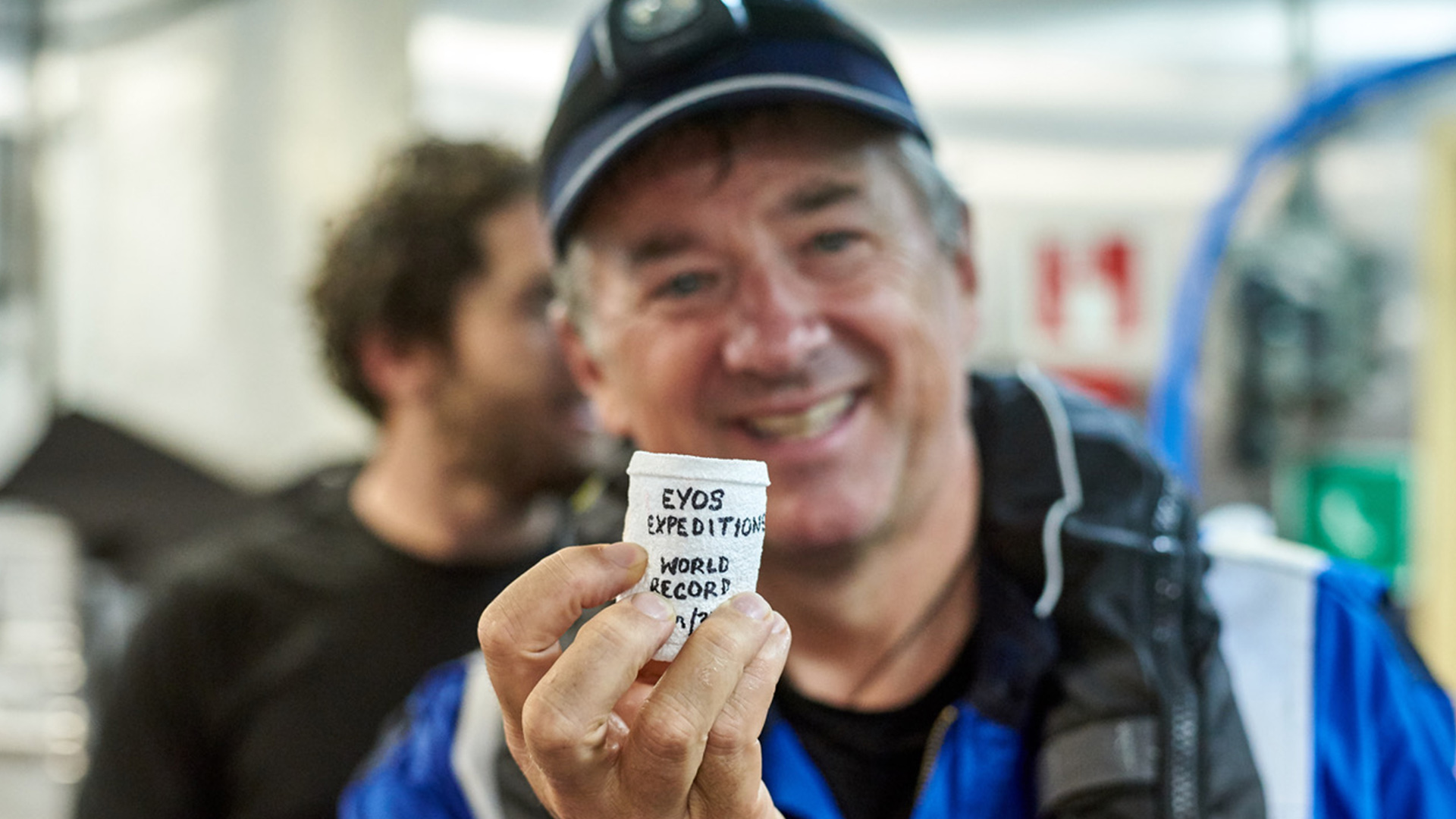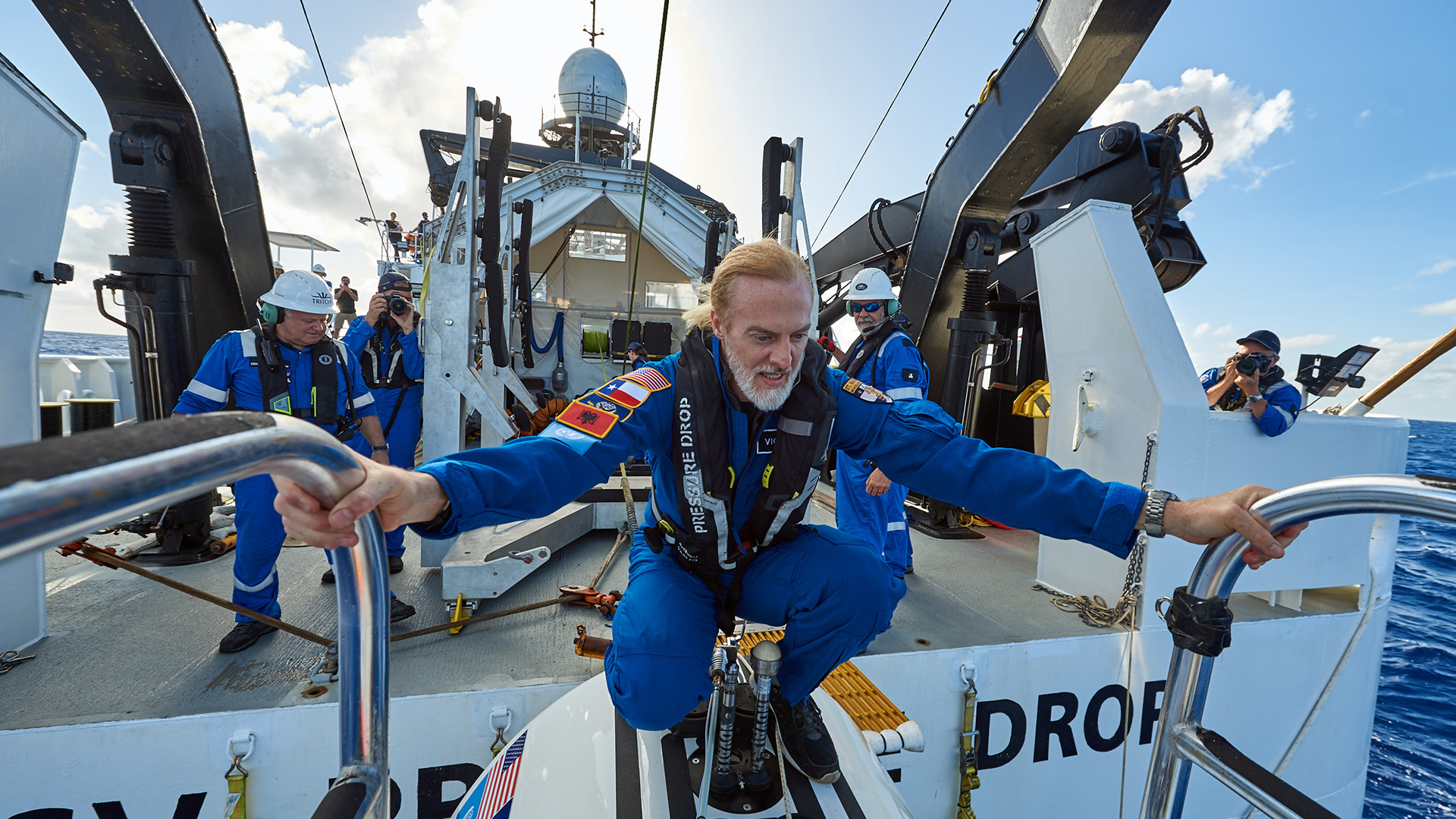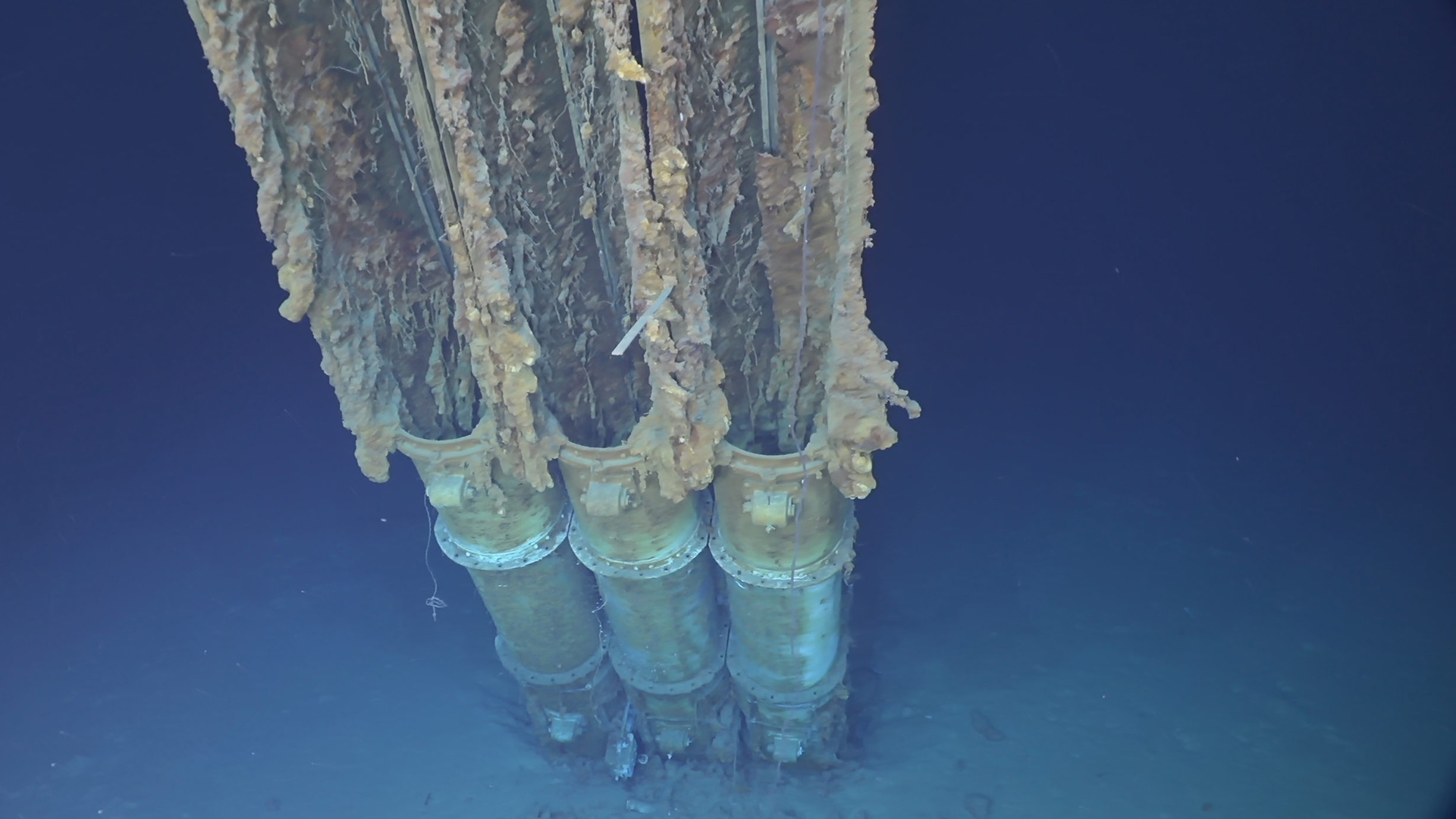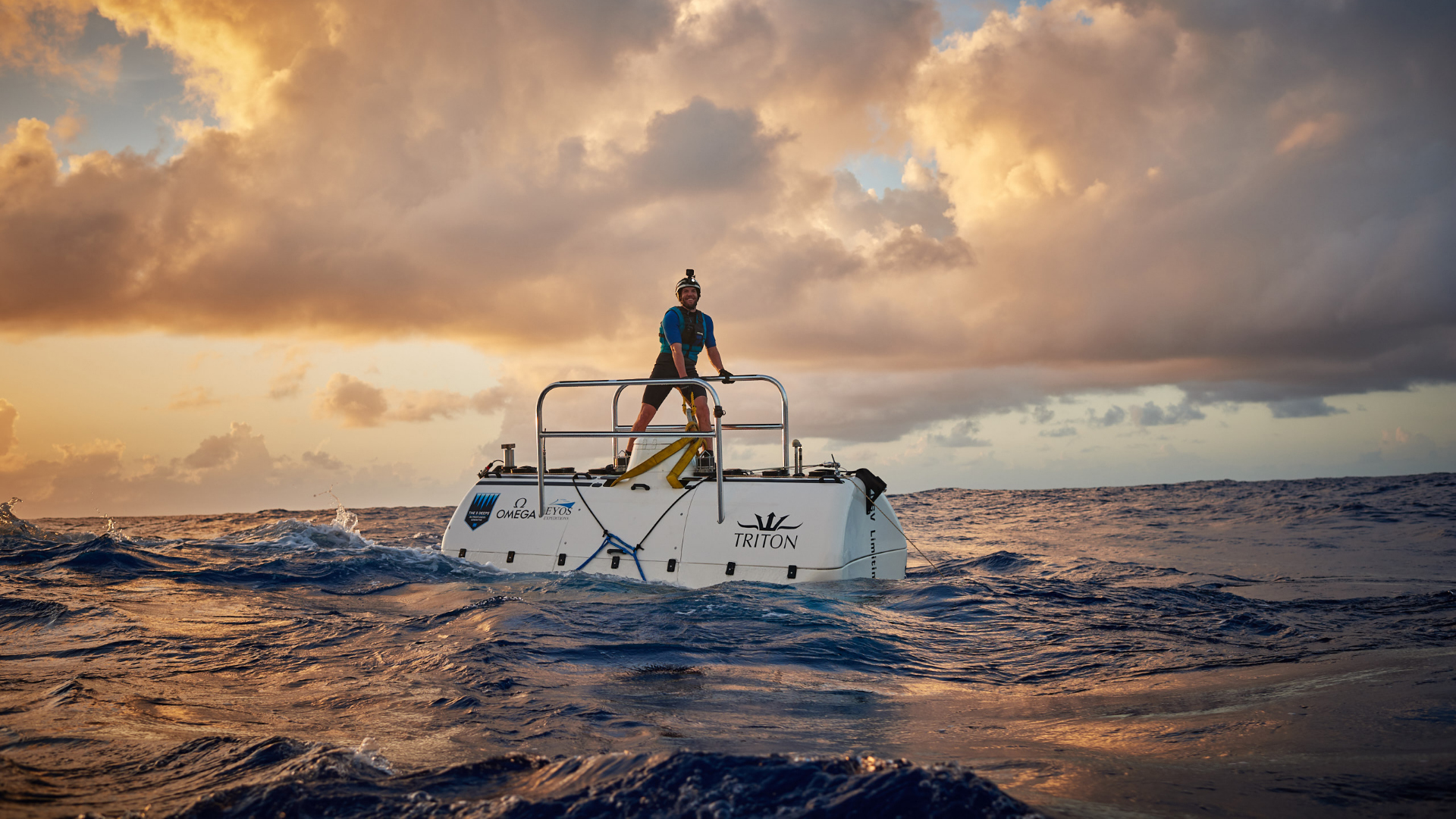In 2012, the Avatar director’s submarine took him to the bottom of the Challenger Deep. Ten years on, the Mariana Trench is a crowded place.
In the spring of 2014, two men met at a downtown diner in Dallas, Texas, to discuss the most ambitious feat of human exploration since the moon landings. One was Rob McCallum, a softly-spoken New Zealander, who ran an adventure consultancy called EYOS. The other was Victor Vescovo, a rangy, gregarious Texan who had made a fortune in stocks and shares.
The meeting lasted barely 45 minutes. But over coffee and eggs, the two men formulated a plan to send Vescovo to all five of the deepest points of the world’s oceans – the five deeps – in one continuous round-the-world voyage. No submarine existed that could achieve such depths; Vescovo said he would invent one. He would also buy the ship to carry the vessel and cover the running costs of the entire year-long expedition: about $50 million for the sub and the ship, and $1 million per month at sea. His descents would not only include the first dives to the deepest trenches of the Southern and Arctic oceans, but also the Mariana Trench’s Challenger Deep. The world’s deepest underwater point, it is the spot where the Pacific Ocean plunges 10,935 metres down – over 2,000 metres deeper than Everest is tall.
At that time, only two other people alive had made it to the bottom. Don Walsh, a retired naval officer inhis 90s, was the only surviving member of the first 1960 expedition to reach the Challenger Deep in thebathyscaphe Trieste. And the other was the film director James Cameron.
His long-delayed Avatar sequel, The Way of Water, is currently in cinemas, and has been extensively marketed on its ground-breaking underwater photography. But Cameron has long been obsessed by the deep ocean – and outlandish technical challenges. And in 2012, the director of Titanic and The Abyss took this passion to its logical extreme and became the first person since Walsh to return to the Challenger Deep.
At that meeting in Dallas, though, Vescovo had two requests. First, his submersible – the Limiting Factor – should be fully reusable, its depth capability unlimited. (Neither Walsh or Cameron’s vesselswere fit for repeated journeys.) And that he would go down deeper, and stay longer, than previous expeditions had managed. After all, when it comes to millionaire one-up-manship, there’s no flex quite like being the deepest human being alive.
The deepest parts of the ocean offer more than simply a fresh frontier for big-man bragging, though. More than 80 per cent of the earth’s ocean remains uncharted. And the potential for discoveries that could aidmedical or scientific progress is vast. Just one 2022 expedition, for instance, uncovered more than 22 unknown species. And while it’s unlikely there are giant prehistoric sharks swimming down there, à la The Meg, it’s not beyond possibility.
In 1938, after all, fishermen pulled a coelacanth from the water. This “living fossil” was an ancestor of modern-day fish, and thought to have gone extinct 65 million years ago. More alarmingly, in 1997, researchers picked up a mysterious “Bloop” sound emanating from the deep ocean. Far louder than any marine life previously recorded, it was the inspiration for Matt Reeves’s 2008 monster feature Cloverfield.
But even if it were lifeless, the “hadal zone” – the deepest part of the ocean – would be astronomically valuable. Deep-sea mining is fantastically controversial – no less than David Attenborough has called for a complete ban. But it could also point to a way out of our current environmental crisis. Its supporters argue that an undersea bounty of rare minerals, such as manganese, nickel, cobalt and copper, will be crucial to a new cleaner, greener industrial revolution. In fact, the sub-sea scramble for resources has already begun; in the absence of realistically-enforceable regulations, many companies (and some states) take the attitude of dive first, ask permission later.
This attention on the deep ocean, however, is relatively recent. People have attempted to push beyond the boundaries of a lungful of air since prehistory. But it was only in the 20th century that technology allowed people to go deeper than the first few hundred feet of water.
In 1926, Yves le Prieur invented the first SCUBA – self-contained underwater breathing apparatus – gear. It allowed divers to float free without cumbersome lead-lined boots, drifting like the marine life whose world they had entered. More prosaically, it also prevented many ghastly deaths: divers were no longer reliant on a vulnerable breathing tube snaking to the surface. Yet even with le Prieur’s invention, humans were still squishy, hairless mammals with delicate internal physiognomy. Cold, pressure and the threat of decompression illness – the “bends” – means no scuba diver has reached beyond 332 metres.
The innovation, then, which truly opened up the deep ocean was the ability to reinforce steel hulls. With thickened walls, submarines could go deeper. Yet even so, despite their widespread use during WWII, few submarines had dived much more than 300 feet down by the 1940s.
The Cold War changed all that. In a mirror of the space race, tensions between the US and the Soviet Union fired the starting gun on a dash to the bottom; deep-sea exploration became a spur to technological progress and a symbol of national pride. And – in a foreshadowing of our own fearsabout Russian machinations – it was seen as vital to geopolitical security: the deep seas were, and remain, a potentially unlimited canvas for espionage, disruption and sabotage.
In fact, Don Walsh was monitoring for Soviets subs when the call came for volunteers for the Trieste expedition to the Challenger Deep. He was kicking his heels in a staff position in San Diego and he was bored, he tells me on video call from his ranch in Oregon, sharp and witty at 91, correcting my pronunciation of “bathyscaphe” by way of introduction.
“I was a sailor and I was desperate to get back to the ocean,” he recalls. “So when they asked for volunteers, I was like: ‘Has Pinocchio got wooden nuts?’ In bureaucracies, people are afraid of the unknown and the new. They wanted two servicemen – it looked like interesting work, so I put my hand up. Turns out I was the only one [who volunteered].”
Walsh joined the project in January 1959 and was made officer-in-charge (equivalent to captain) of the Trieste. The US Navy had acquired the vessel from the Swiss physicist Auguste Piccard a few years before. Piccard’s unique design involved a small, cannonball- like steel chamber, slung beneath a vast balloon filled with lighter-than-water petrol. Like a hot-air balloon, pilots controlled ascent and descent via lead weights – once they hit maximum depth, ballast was jettisoned and the vessel would shoot back to the surface.
Piccard named his strange submersible after the city where it was built, and called it a bathyscapheafter the Greek for “deep” and “ship”. But when he first saw it, Walsh wasn’t impressed. “It looked likean explosion in a boiler factory,” he laughs.
Throughout the next year, Walsh and his small team put Piccard’s underwater blimp through its paces, diving to ever-greater depths. Partly through operational secrecy, and partly because the project flew deliberately under the radar of naval higher-ups, they adopted a self-reliant, make-do-and-mend approach. During one test 6,000 ft dive, they found the Trieste’s protective casing buckled under the temperature differential as it climbed back into warmer waters. Their engineer’s solution was typical ofthe project’s jury-rigged spirit: he simply wrapped the craft in rubber and steel bands – and relied on water pressure to hold the vessel together. “We were inventors by necessity,” says Walsh. “It’s the burden and fun of pioneering in a new field.”
By New Year 1960, they were ready to try for the Challenger Deep. But they weren’t sure exactly where the deepest part of the Mariana Trench lay and, back then, sonar wasn’t sophisticated enough to take soundings to that depth. So Walsh and his crew spent a productive couple of days hurling TNT over the side of the boat and listening to the booms which echoed back from the sea bed. It was crude. But effective – “We didn’t care about exact measurement, only that 14 seconds was deeper than 12 seconds and so on,” says Walsh. Eventually, they found their dive site.
On the morning of January 23 1960, Walsh and Jacques Piccard – Auguste’s son, who had helped his father with the Trieste’s design – spelunked their way down the bathyscaphe’s narrow entrance way and into its cockpit. Neither man was especially tall, but manoeuvring around the Mini-sized space was difficult. They would stay bottled like this for the next nine hours.
The dive, though, was nearly nixed at the last minute. Walsh’s superiors had become jumpy about the project’s danger and cost – and on the day of the attempt, they ordered a halt. The ship’s commander, though, “mislaid” this instruction until Walsh and Piccard were already 20,000ft under and, alas, beyond the reach of comms.
Things went smoothly until around 31,000 ft. At that moment, they heard a rumbling boom and the Trieste jolted to the side. “In the past we had some very small external components fail,” says Walsh.“But this noise was much lower in pitch, as if something big had broken.”
They stopped, but nothing seemed awry on their instruments, so they carried on. After three hours, they touched the sea floor. Seven miles down, Walsh and Piccard shook hands and snapped a selfie, clutching national flags. In the picture, both look glum and nervous. As well they might – when Walshpeered out of the viewing portal, he could barely see anything. Their impact had stirred up a cloud of silt “like being inside a milk bottle”. But he did manage to spot the source of the earlier sound: the pressure had cracked a window in the entranceway. If it gave out completely, their escape route would be flooded.
Deciding they had pushed their luck far enough, they released the remaining ballast and began to climb. They had been on the bottom for only 20 minutes, while their journey upwards took three hours. The Trieste surfaced in heavy seas. And as Walsh and Piccard held tight on deck, waiting to be picked up, they reflected on their achievement. “We were trying to stay dry, noodlingback and forth about when someone might go back,” remembers Walsh. “And we’d agreed it would probably be two years. In the end, it was 52.”
Despite living more than half his life in the shadow of those nine hours, Walsh still enjoys discussing them. “I’ve been dipped in its myth for six decades,” he says. “I was only on the project for three and ahalf years. Yet here we are, 64 years later, still talking about it. I like to think of it as my payback programme, though. The Trieste changed my life.”
One of those changes came after Walsh retired from the navy. He took a position in oceanography at the University of Southern California. But he also moonlighted as a technical consultant in Hollywood. Which is where he met James Cameron.
“He asked me to come to his offices in Malibu as he had an idea he didn’t want to discuss over thephone,” Walsh remembers. “He told me: ‘I’ve got a dream for a manned return to the Challenger Deep. And I want to be the one to go.’”
Cameron was then coming off the back of the success of Titanic, Abyss and Terminator 2. But those around him recalled that it was the technical challenges of the underwater filming for Titanic and Abyss which most occupied him. He was more engineer than filmmaker – a trait which, if the none-too-flattering criticism Avatar 2: The Way of Water is to be believed, has now fully consumed him.
“He’s a very intelligent and curious man,” says McCallum, the adventure consultant who served as Cameron’s technical lead for his Challenger Deep dive. “As with Don and Victor, what drives him is curiosity. That, and an element of perfectionism – whatever Jim does, he does extremely well.”
This perfectionism suited McCallum. “[Deep sea exploration] is about being comfortable with the technology. People think it’s all staring death in the face, but actually you’re trying to be as conservative and boring as possible. After all, it only counts as a dive if you come back up, right?”
Cameron’s passion project grew slowly, under deep secrecy. Walsh remembers being invited out to inspect his sub in the late 2010s. He was told to report to an industrial estate on the outskirts of Sydney. “It was kind of a strip mall – here’s a painter, here’s a cabinet maker, a vehicle repair shop. It was the perfect camouflage as he was very keen to keep it out of the public eye.”
Tucked between these non-descript businesses was Cameron’s extraordinary machine, the Deepsea Challenger. A far more elegant design than Walsh’s underwater dirigible, it looked like a thin yellow pill-tube with a viewing capsule at its bottom. “It was amazing to see this thing,” says Walsh. “He is one bright engineer – he’s never been trained, but he’s intuitive. He’s what we call a ‘shade tree engineer’. He’slike those guys down in Mexico who can rebuild a car with just a hammer and a saw.”
By the time Cameron was ready to make his attempt in 2012, his secret had surfaced. Unlike the Trieste expedition, the Deepsea Challenger expedition was sponsored by Rolex and filmed by National Geographic. The resulting footage made front-page news for weeks afterwards.
On March 26 2012, Cameron squeezed his 6ft 1 frame into his one-man bathyscaphe. The last person he spoke to was Walsh, who shook his hand before he clambered inside its 42 inch-thick reinforced steel capsule. Jacques Piccard had died in 2008, so Walsh watched as Cameron sank beneath the waves, hoping to join a very exclusive club of two.
The Deepsea Challenger took two and half hours to travel the seven miles down. Cameron was able to slow his landing so he avoided kicking up the sediment that had choked the Trieste. He put through a call to his wife and began puttering around using its thrusters. “It’s a completely alien world,” he remembered later. “It’s a very lunar, very desolate place.”
He spent three hours on the bottom. And while he’s not a man prone to poeticism, the experience clearly shook him. “I felt complete isolation from all of humanity,” he said. “In the space of one day, I’d gone to another planet and come back.”
As McCallum predicted, the well-rehearsed dive protocols went smoothly. But there was one moment which rattled Cameron: now keen to ascend, the delay as the weights detached to send him back to the surface was excruciating. “You’re always relieved,” he said. “Because the alternative is not pretty.”
He resurfaced in just over an hour, having reached a maximum depth of 10,908m, slightly less than the Trieste’s dive. The plan had been to reuse the Deepsea Challenger for further exploration, but it was damaged in a truck fire while being transported to the Woods Hole Oceanographic Institute. Cameron would have to be content with his record.

This wasn’t an issue until Victor Vescovo came on the scene. On April 28 2019, Vescovo became the third living human being to breach the hadal zone of the Mariana Trench – the very deepest point of the Pacific ocean. It was the fourth dive in his Five Deeps expedition, which had then been at sea for six months. Vescovo spent four hours on the bottom: the longest anyone had spent at that depth. Then, three days later, he went down again. Over the next week, the Limiting Factor made a further three dives, with various crew members along for the ride.
“It was like he’d made a daily flight to the moon possible,” remembers McCallum. “Victor advanced the game quite a long way – because now we had an extremely manoeuvrable multi-person sub, capable of going to any part of the deep ocean.”
Press access around the Five Deeps expedition was tight. In fact, McCallum recalls one of his greatest headaches – alongside government permits, and later, Covid-19 – was ensuring none of the crew broke news of its dives on social media. But on May 13, its comms team sent out a press release: “Deepest Submarine Dive in History, Five Deeps Expedition Conquers Challenger Deep.”
That statement claimed Vescovo’s first dive, to the ‘eastern pool’ of the Challenger Deep, had reached a maximum depth of 10,935m – 27 metres deeper than James Cameron had achieved.
When the New York Times reported the news, Cameron emailed the newspaper with a “request to speak”. He went on record, querying Vescovo’s claim. He noted that, as the bottom was flat, Vescovo couldn’t possibly have gone deeper than he had.
“I question that result,” Cameron said. “And I question why no one else has questioned it too. At the risk of sounding like sour grapes, it’s important for the public to know that the one deepest point in our world’s oceans is a flat, featureless plain.” (As geophysicist Mark Zumberge told Popular Science, it doesn’t much matter who’s right in any case. “There’s not a great scientific interest in how the ocean floor varies in a few meters,” he said.)
When I speak to him, Vescovo – an intense, charismatic man, his greying hair pulled back in a ponytail – does a good job of appearing magnanimous. But Cameron’s accusation evidently still rankles.
“I’ve no animus towards him, and I really admire his films,” he says. “But the issue is he’s saying the Challenger Deep is billard-table flat – it’s not. I’ve been to all three parts of it a total of 15 times. I’ve personally spent 36 hours on the bottom. It’s a combination of gently sloping plains, and sharp escarpments. At one point, I even encountered a 200m vertical cliff.”
Later in our conversation, Cameron, unbidden, bops up again. “It’s so frustrating,” says Vescovo. “I get why he’s passionate about [who got deeper]. But for me, it’s a scientific debate – a matter of data collection and analysis.”
Indeed, Vescovo reels off his expedition’s scientific achievements with fluent ease. “We found the two deepest shipwrecks ever recorded,” he explains. “We travelled the world three times, discovering 40 new species and mapping more than 4 million kilometres of sea floor. I dived tothe bottom of 17 ocean trenches.”
Yet his motivations can’t have been entirely selfless. Surely an element of ego was involved?
“It appealed to the adventurer in me,” he concedes. “I’ve been mountain climbing for 20 years or so, and I’ve summited Everest. And this summer, I went to space. So I’ve had this bizarre triangle of experiences – the raw physicality of mountain climbing, the cerebral and brooding deep oceans and the violence and extraordinary vistas of deep space. I believe I’m the first person in history to have completed that triangle.”
But it’s unlikely he’ll remain the only one for long. The deep oceans are undoubtedly getting busier. Since the Five Deeps, Vescovo’s Limiting Factor has completed several other expeditions, including a circumnavigation of the Pacific Ocean and reaching the deepest parts of the Mediterranean and RedSeas. And this year, after four years of almost continual use, Vescovo sold the submersible and its mother ship to Gabe Newell, the billionaire founder of the Steam gaming platform. “My finances were getting tighter,” says Vescovo, with understatement.
Newell has pledged to continue using the Limiting Factor for scientific research. But it may already have competition – in late 2020, the Chinese government claimed to have sent a three-man sub to the Challenger Deep, but didn’t release any independent verification. It’s a development which worries Vescovo.
“I’m a private individual who can go to the bottom of the ocean whenever I desire,” he says. “But I was also a naval intelligence officer for 20 years. And it was no surprise to me when the Nord Streampipeline had an explosive device attached to it. The entire seafloor is now vulnerable to private technology that is extremely difficult to monitor. It’s a whole new domain of potential conflict – and we just saw the first strike in the Baltics.”
For Walsh, though, deep sea exploration trumps record-setting – or even national security.
“Exploration is about creating new knowledge. It’s curiosity acted upon,” he explains. “The Trieste’s dive is a bookmark in the history of exploration, but we didn’t do it to set a record. We’re not exploring planet Earth as much as we ought to. We’ve sent men off to the moon, but we’re not finished with this manned satellite we live on, this spaceship Earth.”
On one account at least, his legacy is safe. In 2020, Vescovo made another dive to the Challenger Deep. On board was one guest – Kelly Walsh, Don’s son. Almost 60 years to the day, he had returned to the same spot his father had made history. It was Father’s Day.
“He’s in the family business now,” Walsh chuckles. “And that’s a pretty good place to be.”
This article, written by Alex Diggins, was published by The Telegraph Dec 20, 2022.



